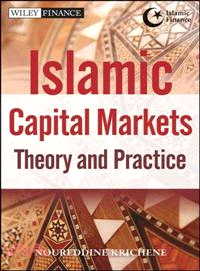商品簡介
Bringing together theoretical and practical aspects of capital markets, Islamic Capital Markets offers readers a comprehensive insight into the institutions, instruments, and regulatory framework that comprise Islamic capital markets. Also exploring ideas about money, central banking, and economic growth theory and their role in Islamic capital markets, the book provides students and practitioners with essential information about the analytical tools of Islamic capital markets, serves as a guide to investing in Islamic assets, and examines risk management and the structure of Islamic financial products.
Author and Islamic finance expert Noureddine Krichene examines the development of leading Islamic capital markets, including Malaysia, looking at sukuks and stocks in detail and emphasizing valuation, duration, convexity, immunization, yield curves, forward rates, swaps, and risks. Analyzing stock markets, stock valuation, price-earnings ratio, market efficiency hypothesis, and equity premiums, the book addresses uncertainty in capital markets, portfolio diversification theory, risk-return trade-off, pricing of assets, cost of capital, derivatives and their role in hedging and speculation, the principle of arbitrage and replication, Islamic structured products, the financing of large projects, and more.
- Emphasizes both theoretical and practical aspects of capital markets, covering analytical concepts such as the theory of arbitrage, pricing of assets, capital market pricing model, Arrow-Debreu state prices, risk-neutral pricing, derivatives markets, hedging and risk management, and structured products
- Provides students and practitioners of finance with must-have information about the analytical tools employed in Islamic capital markets
- Examines all the most recent developments in major Islamic capital markets, including Malaysia
Discussing the advantages of Islamic capital markets and the prospects for their development, Islamic Capital Markets gives readers a fundamental grounding in the subject, with an emphasis on financial theory and real world practice.
作者簡介
DR. NOUREDDINE KRICHENE, PHD, earned a doctorate in economics from the University of California, Los Angeles. He has taught Islamic finance at the Global University, INCEIF, in Malaysia, and was an economist with the International Monetary Fund Economist Program from 1986 to 2009. From 2005 to 2007, he was advisor at the Islamic Development Bank of Saudi Arabia. His areas of expertise are the international payments system, macroeconomic policies, finance, and energy and water economics.
目次
Part One: Islamic Capital Markets: Tools of Securities Investment, Asset Pricing, Risk-Management, and Portfolio Performance
Chapter 1: Capital Theory and Islamic Capital MarketOn the Nature of CapitalOn the Nature of Interest and ProfitCapital Theory in Islamic FinanceTime Preference and Capital MarketsCapital Productivity: The Inter-Temporal Production Opportunity SetGeneral Equilibrium: Time-preference and Capital ProductivityModel of Capital as a Subsistence FundCapital as Engine of GrowthThe Capital Market and The EconomyThe Intermediation Role of the Capital MarketSummaryReferences Questions
Chapter 2: Portfolio Theory and Risk-Return TradeoffMarket UncertaintyPortfolio Diversification TheoryThe Portfolio Diversification in the Case of Two Risky AssetsA Model of Riskless Asset and a Risky AssetAsset Pricing Based on Risk-Return TradeoffThe Security Market LineEfficiency Frontier, Capital Market Line, Characteristic Line, and the Security Market LineThe Cost of Capital Based on the Capital Asset Pricing ModelSummaryReferences Questions
Chapter 3: The Analytics of SukuksValuation of an AssetValuation of SukuksSpot Rates and Forward RatesThe Term Structure of Rates of ReturnSukuk DurationSukuk ConvexityImmunization of Sukuk PortfolioHedging with Futures ContractsUnderstand Risks in SukuksSummaryReferences Questions
Chapter 4: Islamic StocksSharia ScreeningIslamic IndexesSpeculation and GamblingStock YieldCommon Stock ValuationForecasting Stock PricesFundamental and Technical AnalysisThe Efficiency Hypotheses of Stock MarketsEvaluating CompaniesMechanics of TradingSummaryReferences Questions
Chapter 5: The Cost of CapitalObjective of the Firm: Market Value Maximization and the Cost of CapitalProject Selection: the Hurdle RateDefining Capital Cost: the Discount RateThe Net Cash FlowThe Present Value FormulaRelationship Between Risk and the Cost of CapitalEstimating the Cost of Equity Capital and Overall Cost of CapitalCapital Asset Pricing Model (CAPM)Certainty-Equivalent Versus Risk Adjusted Discount RatesApplying the CAPM to Calculate Certainty-Equivalent Cash FlowThe Valuation of Securities, Leverage, and the Cost of Capital: Modigliani and Miller TheoryWeighted Average Cost of Capital: Implications of the Capital Cost Analysis for the Theory of Investment: Capital Structure and Investment PolicyThe Agency ProblemSummaryReferences Questions
Chapter 6: Asset Pricing Under UncertaintyModelling Risk and ReturnMarket Efficiency and Arbitrage-free PricingBasic Principles of Derivatives pricingSummaryReferences Questions
Chapter 7: The Consumption-based Pricing ModelInter-temporal Optimization and Implication to Asset PricingAsset Specific Pricing and Correction for RiskExpected Return-beta RepresentationThe Mean Variance FrontierRisk Neutral Pricing Implied by the General Pricing Formula Consumption-based Contingent Discount FactorsThe Equity Premium and Interest Rate PuzzlesSummaryReferences Questions
Chapter 8: Futures MarketsInstitutional Aspects of Forward and Futures ContractsValuation of Forward and Futures ContractsForeign currencies futures and the yield rate parityHedgingRolling the Hedge ForwardThe Hedge RatioCross HedgeSpeculating in Futures MarketsSummaryReferences Questions
Chapter 9: Stock Index FuturesSpecifications of the Stock Index Futures ContractThe Pricing of a Stock Index Futures contractHedging with Stock Index FuturesThe Minimum Risk Hedge RatioCross HedgeTarget Beta and Capture Alpha with Stock Index FuturesConstructing an indexed portfolioAsset AllocationPortfolio InsuranceIndex ArbitrageProgram TradingSummaryReferences Questions
Chapter 10: Interest Rates Futures Markets and Applications to SukuksTypes of Interest Rate Futures ContractsThe Pricing of Sukuk Forward ContractsHedging with Interest Rate FuturesInterest Rate Futures in Sukuk Portfolio ManagementImmunization of Sukuk Portfolio with Interest Rate FuturesSummaryReferences Questions
Chapter 11: Basic Principles of OptionsOptions: Basic DefinitionsTrading StrategiesOption PricingPricing the Put OptionCall Put ParityThe Binomial Model: Extension to Two PeriodsThe Option DeltaRisk Neutral PricingThe Black Scholes (BS) ModelCurrency OptionsCaps and FloorsSummaryReferences Questions
Chapter 12: SwapsStructure and Payoff of a SwapMotivations for the SwapThe valuation of Plain Vanilla Swaps: the Swap RateCurrency SwapsPricing a Currency SwapEquity SwapCredit Default SwapTotal Return SwapStructured Notes: Inverse Floater and Bear FloaterOptions on Interest Rate Swaps: SwaptionsInterest Rate Swaps as Hedging InstrumentsSummaryReferences Questions
Chapter 13: Mutual FundsWhat is a Mutual Fund? How Does a Mutual Fund Work?Index Funds and Hedge FundsTypes of Mutual FundsFees and ExpensesRegulationsMutual Fund PerformanceMutual fund Advantages and RisksSummaryReferences Questions
Chapter 14: Portfolio Performance and Value-at-RiskNature and Purpose of the Performance EvaluationMeasuring PerformanceMethodologies for Evaluating PerformanceThe Fama-French Three Factor ModelPerformance Attribution ModelsValue at Risk (VaR)Methods for Calculating VaRStress Testing and Back TestingSummaryReferences Questions
Part Two: Money and Capital Markets
Chapter 15: The Banking SystemOn the Nature of Central BankingOn the Nature of MoneyFractional Banking and the Money MultiplierThe Central BankThe Reserves Market: Demand and Supply of ReservesThe Regulatory and Supervisory Role of the Central BankThe Debate Over the Role of the Central BankThe Theory of Two Interest RatesCentral Banking and Financial MarketsCentral Bank in Islamic FinanceSummaryReferences Questions
Chapter 16: The Demand for MoneyMotives for Holding MoneyDemand for Money as Affected by the Rate of InterestThe Baumol-Tobin Model of Money DemandEquilibrium in the Market for MoneyDemand for Money as Influenced by the Price LevelOther Determinants of the Demand for MoneyEffects of Changes in the Money MarketThe Quantity Theory of Money and Money DemandThe Cambridge Transaction ApproachThe Restatement of the Quantity Theory as a Demand for Money FunctionSummaryReferences Questions
Chapter 17: Capital Markets and The Macro-EconomyFinancial Crises and Approaches for RecoveryThe Income-expenditure SectorThe Monetary SectorMacroeconomic EquilibriumMacroeconomic Equilibrium Under Keynesian AssumptionsClassicists’ Approaches to Recovery from DepressionIslamic Approaches to Recovery from DepressionStagflation and Post-2008 Crisis UnemploymentSummaryReferences Questions
Part Three: Regulations and Institutions of Capital Markets and Islamic Structured Finance
Chapter 18: Institutions and Regulations of Capital MarketsRegulatory LegislationThe Securities and Exchange CommissionThe US Commodity Futures Trading Commission (CFTC)The Stock MarketBrokerage FirmOnline Trading: A form of Discount BrokerageInvestment AdvisersClearinghouseCentral Securities DepositoryInvestment BanksInvestment CompaniesInvestment FundsMutual FundsExchange-traded FundHedge FundsMoney Market FundStructured Investment VehicleSummaryReferences Questions
Chapter 19: Institutions and Instruments of Islamic Capital MarketsThe Sharia Advisory CouncilIslamic Modes of Financing and Islamic InstrumentsIslamic FundsIslamic Derivatives MarketsGuidelines on the Offering of Islamic SecuritiesSummaryReferences Questions
Chapter 20: SukuksAsset SecuritizationStructure and Legal Documentation of Islamic Private Debt SecuritiesTypes of Sukuk StructuresSukuk Issuance in PracticeRisks Underlying Sukuks StructuresManaging the Financial Risks of Sukuk StructuresSummaryReferences Questions
Chapter 21: Islamic Structured ProductsStructured FinanceDefinition of Structured ProductsFeatures of Structures ProductsRisks and Benefits of Structured ProductsTypes of Structured ProductsFinancial Engineering of Structured ProductsIslamic Structured ProductsProfit Rate Swap Structure Based on Simplified Parallel MurabahaChallenges for Islamic StructurersExamples of Structured ProductsSummaryReferences Questions
About the AuthorIndex
主題書展
更多書展本週66折
您曾經瀏覽過的商品
購物須知
外文書商品之書封,為出版社提供之樣本。實際出貨商品,以出版社所提供之現有版本為主。部份書籍,因出版社供應狀況特殊,匯率將依實際狀況做調整。
無庫存之商品,在您完成訂單程序之後,將以空運的方式為你下單調貨。為了縮短等待的時間,建議您將外文書與其他商品分開下單,以獲得最快的取貨速度,平均調貨時間為1~2個月。
為了保護您的權益,「三民網路書店」提供會員七日商品鑑賞期(收到商品為起始日)。
若要辦理退貨,請在商品鑑賞期內寄回,且商品必須是全新狀態與完整包裝(商品、附件、發票、隨貨贈品等)否則恕不接受退貨。























